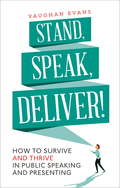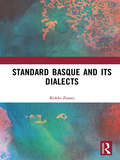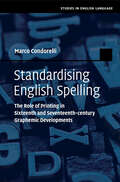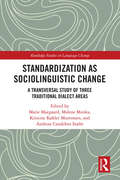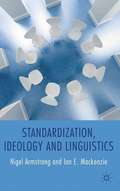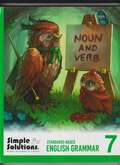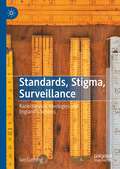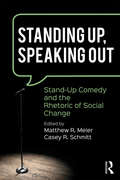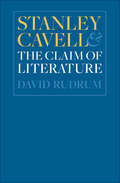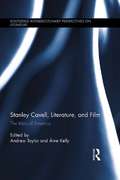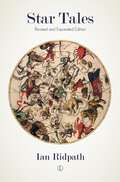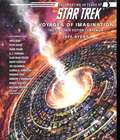- Table View
- List View
Stand, Speak, Deliver!: How to survive and thrive in public speaking and presenting
by Vaughan EvansPublic speaking and presenting rank in the top ten of people's greatest fears. Yet being able to speak coherently and persuasively in a speech, seminar or meeting room is important when progressing our careers and living our lives to the fullest.In this book, 37 pithy, lively and witty mini-speeches tell us how to construct and deliver a speech or presentation. Each example speech follows a simple, perfect structure which will soon become imprinted in your mind. Each focuses on one facet of speaking and gives you the very essentials picked up by the author over 25 years of experience.And each speech will entertain as much as inform you.Stand, Speak, Deliver! will enable you to learn how to use your eyes, vary your voice and move your body. It will also look at how to inform, entertain, humour, persuade, motivate or inspire the audience; how to present, to colleagues or clients; how to introduce a speaker; and how to wow as best man. And you will discover the ultimate secret...!Read the book, enjoy it and you will survive as a speaker. Follow it and you will thrive!
Stand, Speak, Deliver!: How to survive and thrive in public speaking and presenting
by Vaughan EvansPublic speaking and presenting rank in the top ten of people's greatest fears. Yet being able to speak coherently and persuasively in a speech, seminar or meeting room is important when progressing our careers and living our lives to the fullest.In this book, 37 short, lively and pithy speeches tell us how to construct and deliver a speech or presentation. Each example speech follows a simple, perfect structure which will soon become imprinted in your mind. Each focuses on one facet of speaking and gives you the very essentials picked up by the author over 25 years of experience.Stand, Speak, Deliver! will enable you to learn how to use your eyes, vary your voice and move your body. It will also look at how to inform, entertain, humour, persuade, motivate or inspire the audience; how to present, to colleagues or clients; how to introduce a speaker; and how to wow as best man. And you will discover the ultimate secret...!Read the book and you will survive as a speaker. Follow it and you will thrive!e!
Standard Basque and Its Dialects
by Koldo ZuazoThe origins of Basque dialects, a highly disputed area of research in Basque studies, are examined. The author, the foremost expert on Basque dialects, traces their emergence to medieval times, using: a) the profusion of features common to all dialects: b) the large number of innovations common to all dialects; and c) the fact that the only truly divergent dialects are the western and Souletin ones. In contrast, the three central dialects differ in far fewer and less important respects. The main contribution of Standard Basque and Its Dialects to the scholarly debate about the formation of Basque is that it identifies the nuclei from which the current dialects almost certainly emerged. The book explains the points of view that Basque speakers have upheld concerning their dialects, the formation of provincial standards starting in the eighteenth century, and the launch of Standard Basque in the second half of the twentieth century.
Standard English: The Widening Debate
by Richard J. Watts Tony BexStandard English draws together the leading international scholars in the field, who confront the debates surrounding 'Standard English', grammar and correctness head-on.These debates are as intense today as ever and extend far beyond an academic context. Current debates about the teaching of English in the school curriculum and concerns about declining standards of English are placed in a historical, social and international context. Standard English:* explores the definitions of 'Standard English', with particular attention to distinctions between spoken and written English* traces the idea of 'Standard English' from its roots in the late seventeenth century through to the present day.This is an accessible, seminal work which clarifies an increasingly confused topic. It includes contributions from: Ronald Carter, Jenny Cheshire, Tony Crowley, James Milroy, Lesley Milroy and Peter Trudgill.
Standardising English Spelling: The Role of Printing in Sixteenth and Seventeenth-century Graphemic Developments (Studies in English Language)
by Marco CondorelliThe standardisation of English spelling that resulted from the advent of printing is one of the most fascinating aspects of the history of English. This pioneering book explores new avenues of investigation into spelling development by looking at the Early Modern English period, when irregular features across graphemes became standardised. It traces the development of the English spelling system through a number of 'competing' standards, raising questions about the meaning of 'standardisation'. It introduces a new model for the analysis of large-scale graphemic developments from a diachronic perspective, and provides a new empirical method geared specifically to the study of spelling standardisation between the sixteenth and seventeenth centuries. The method is applied to four interconnected case studies, focusing on the standardisation of positional spellings, i and y, etymological spelling and vowel diacritic spelling. This book is essential reading for researchers of writing systems and the history of English.
Standardising English: Norms and Margins in the History of the English Language
by Diana Lewis Linda Pillière Wilfrid Andrieu Valérie KerfelecThis path-breaking study of the standardisation of English goes well beyond the traditional prescriptivism versus descriptivism debate. It argues that the way norms are established and enforced is the result of a complex network of social factors and cannot be explained simply by appeals to power and hegemony. It brings together insights from leading researchers to re-centre the discussion on linguistic communities and language users. It examines the philosophy underlying the urge to standardise language, and takes a closer look at both well-known and lesser-known historical dictionaries, grammars and usage guides, demonstrating that they cannot be simply labelled as 'prescriptivist'. Drawing on rich empirical data and case studies, it shows how the norm continues to function in society, influencing and affecting language users even today.
Standardization as Sociolinguistic Change: A Transversal Study of Three Traditional Dialect Areas (Routledge Studies in Language Change)
by Marie Maegaard Malene Monka Kristine Køhler Mortensen Andreas Candefors StæhrThis volume seeks to extend and expand our current understanding of the processes of language standardization, drawing on both quantitative and qualitative approaches to examine how linguistic variation plays out in various ways in everyday life in Denmark. The book compares linguistic variation across three different rural speech communities, underpinned by a transversal framework, which draws upon different methodological and analytical approaches, as well as data from different contexts across different generations, and results in a nuanced and dynamic portrait of language change in one region over time. Examining communities with varying degrees of linguistic variation with this multi-layered framework demonstrates a broader need to re-examine perceptions of language standardization as a unidirectional process, but rather as one shaped by a range of factors at the local level, including language ideologies and mediatization. A concluding chapter by eminent sociolinguist David Britain brings together the conclusions drawn from the preceding chapters and reinforces their wider implications within the field of sociolinguistics. Offering new insights into language standardization and language change, this book will be of particular interest to students and scholars in sociolinguistics, dialectology, and linguistic anthropology.
Standardization, Ideology and Linguistics
by Nigel Armstrong Ian E. MackenzieThe authors explore some of the ways in which standardization, ideology and linguistics are interrelated. Through a number of case studies they show how concepts such as grammaticality and structural change covertly rely on a false conceptualization of language, one that derives ultimately from standardization.
Standardizing Diversity: The Political Economy of Language Regimes (National and Ethnic Conflict in the 21st Century)
by Amy H. LiuLanguages have deep political significance beyond communication: a common language can strengthen cultural bonds and social trust, or it may exacerbate cultural differences and power imbalances. Language regimes that emerge from political bargains can centralize power by favoring the language of one ethnolinguistic group, share power by recognizing multiple mother tongues, or neutralize power through the use of a lingua franca. Cultural egoism, communicative efficiency, or collective equality determines the choice. As Amy H. Liu demonstrates, the conditions surrounding the choice of a language regime also have a number of implications for a nation's economy.Standardizing Diversity examines the relationship between the distribution of linguistic power and economic growth. Using a newly assembled dataset of all language-in-education policies in Asia from 1945 to 2005 and drawing on fieldwork data from Malaysia and Singapore, Liu shows language regimes that recognize a lingua franca exclusively—or at least above all others—tend to develop social trust, attract foreign investment, and stimulate economic growth. Particularly at high levels of heterogeneity, the recognition of a lingua franca fosters equality and facilitates efficiency. Her findings challenge the prevailing belief that linguistic diversity inhibits economic growth, suggesting instead that governments in even the most ethnically heterogeneous countries have institutional tools to standardize their diversity and to thrive economically.
Standardizing Minority Languages: Competing Ideologies of Authority and Authenticity in the Global Periphery (Routledge Critical Studies in Multilingualism)
by Pia Lane James Costa Haley De KorneThe Open Access version of this book, available at https://www.taylorfrancis.com/books/9781138125124, has been made available under a Creative Commons Attribution-Non Commercial-No Derivatives 4.0 license. This volume addresses a crucial, yet largely unaddressed dimension of minority language standardization, namely how social actors engage with, support, negotiate, resist and even reject such processes. The focus is on social actors rather than language as a means for analysing the complexity and tensions inherent in contemporary standardization processes. By considering the perspectives and actions of people who participate in or are affected by minority language politics, the contributors aim to provide a comparative and nuanced analysis of the complexity and tensions inherent in minority language standardisation processes. Echoing Fasold (1984), this involves a shift in focus from a sociolinguistics of language to a sociolinguistics of people. The book addresses tensions that are born of the renewed or continued need to standardize ‘language’ in the early 21st century across the world. It proposes to go beyond the traditional macro/micro dichotomy by foregrounding the role of actors as they position themselves as users of standard forms of language, oral or written, across sociolinguistic scales. Language policy processes can be seen as practices and ideologies in action and this volume therefore investigates how social actors in a wide range of geographical settings embrace, contribute to, resist and also reject (aspects of) minority language standardization.
Standards Based English Grammar-Simple Solution Grade 7
by Nancy Tondy Regina Webb Joan Archer [et al.] Nancy L. McGrawMinutes a Day-Mastery for a Lifetime!
Standards of English
by Raymond HickeyThe notion of a 'standard' variety of English has been the subject of a considerable body of research. Studies have tended to focus on the standard features of British and American English. However, more recently interest has turned to the other varieties of English that have developed around the world and the ways in which these have also been standardised. This volume provides the first book-length exploration of 'standard Englishes', with chapters on areas as diverse as Canada, the Caribbean, Africa, Asia, New Zealand and the South Pacific. This is a timely and important topic, edited by a well-known scholar in the field, with contributions by the leading experts on each major variety of English discussed. The book presents in full the criteria for defining a standard variety, and each chapter compares standards in both spoken and written English and explores the notion of register within standard varieties.
Standards of English in Higher Education
by Neil MurrayThe student demographic of universities today has changed quite dramatically from even a decade ago. As universities seek to internationalise, widen participation and derive attendant reputational and financial benefits, along with greater opportunities for research collaborations and industry links, they also face a growing challenge associated with what Neil Murray terms 'the English language question'. In particular, as the proportion of students of non-English speaking backgrounds entering universities increases, there is growing concern over levels of language proficiency and what this can mean for educational standards, the student experience and, ultimately, institutional standing. Standards of English in Higher Education unpacks a number of key and interrelated issues - for example, the assessment of proficiency and the structure and nature of provision - that bear on the question of English language standards and in doing so offers a frank critical appraisal of English language in higher education today.
Standards, Stigma, Surveillance: Raciolinguistic Ideologies and England’s Schools
by Ian CushingThis book traces raciolinguistic ideologies in England’s schools, focusing on post- 2010 policy reforms which frame the language practices of low-income, racialised speakers as limited and deficient. Across interviews, policy mechanisms and classroom observations, the author shows how raciolinguistic ideologies are rooted in British colonial logics which continue to shape contemporary education policy. He shows how these policies require marginalised speakers to modify their speech patterns in line with normative standards of whiteness under new guises of social justice and research robustness. Finally, new visions for language education and linguistic justice are offered, demonstrating how teachers can see themselves as language activists to identify, resist and reject faults in a hostile and oppressive policy architecture. This book draws on fields including critical language policy, educational sociolinguistics, genealogy, raciolinguistics and critical language awareness.
Standing Up, Speaking Out: Stand-Up Comedy and the Rhetoric of Social Change
by Matthew R. Meier Casey R. SchmittIn recent decades, some of the most celebrated and culturally influential American oratorical performances have come not from political leaders or religious visionaries, but from stand-up comics. Even though comedy and satire have been addressed by rhetorical scholarship in recent decades, little attention has been paid to stand-up. This collection is an attempt to further cultivate the growing conversation about stand-up comedy from the perspective of the rhetorical tradition. It brings together literatures from rhetorical, cultural, and humor studies to provide a unique exploration of stand-up comedy that both argues on behalf of the form’s capacity for social change and attempts to draw attention to a series of otherwise unrecognized rhetors who have made significant contributions to public culture through comedy.
Standing at the Threshold: Working through Liminality in the Composition and Rhetoric TAship
by Brady Edwards Kathryn M. Lambrecht Phillip Lovas William J. Macauley Jr. Leslie AngleseyStanding at the Threshold articulates identity and role dissonances experienced by composition and rhetoric teaching assistants and reimagines the TAship within a larger professional development process. Current researchers and scholars have not fully explored the liminality of the profession’s traditional path to credentialing. This collection reconsiders these positions and their contributions to academic careers. These authors enrich the TA experience by supporting agency and self-efficacy, encouraging TAs to take active roles in understanding their positions and making the most of that experience. Many chapters are written by current or former TAs who are writing as a means of preparing, informing, and guiding new rhet/comp TAs, encouraging them to make choices about how they want to think through and participate in their teaching work. The first work on the market to delve deeply into the TAship itself and what it means for the larger discipline, Standing at the Threshold provides a rich new theorizing based in the real experiences and liminalities of teaching assistants in composition and rhetoric, approached from a productive array of perspectives. Contributors: Lew Caccia, Lillian Campbell, Rachel Donegan, Jaclyn Fiscus-Cannady, Jennifer K. Johnson, Ronda Leathers Dively, Faith Matzker, Jessica Restaino, Elizabeth Saur, Megan Schoettler, Kylee Thacker Maurer
Standing by Words: Essays
by Wendell BerryIn these six essays, award-winning author Wendell Berry considers the degeneration of language that is manifest throughout our culture, from poetry to politics, from conversation to advertising, and he shows how the ever widening cleft between words and their referents mirrors the increasing isolation of individuals from their communities and of their communities from the land.
Standing by the Ruins: Elegiac Humanism in Wartime and Postwar Lebanon
by Ken SeigneurieSince the mid-1970s, Lebanon has been at the center of the worldwide rise in sectarian extremism. Its cultural output has both mediated and resisted this rise. Standing by the Ruins reviews the role of culture in supporting sectarianism, yet argues for the emergence of a distinctive aesthetic of resistance to it. Focusing on contemporary Lebanese fiction, film, and popular culture, this book shows how artists reappropriated the twin legacies of commitment literature and the ancient topos of “standing by the ruins” to form a new “elegiac humanism” during the tumultuous period of 1975 to 2005. It redirects attention to the critical role of culture in conditioning attitudes throughout society and is therefore relevant to other societies facing sectarian extremism.Standing by the Ruins is also a strong intervention in the burgeoning field of World Literature. Elaborating on the great Arabist Hilary Kilpatrick’s crucial insight that ancient Arabic forms and topoi filter into modern literature, the author details how the “standing by the ruins” topos—and the structure of feeling it conditions—has migrated over time. Modern Arabic novels, feature films, and popular culture, far from being simply cultural imports, are hybrid forms deployed to respond to the challenges of contemporary Arab society. As such, they can take their place within a World Literature paradigm: they are cultural products that travel and intervene in the world.
Stanley Cavell and the Claim of Literature
by David RudrumAn analysis of the significance of literature in the work of one of America's most influential contemporary philosophers.Stanley Cavell is widely recognized as one of America's most important contemporary philosophers, and his legacy and writings continue to attract considerable attention among literary critics and theorists. Stanley Cavell and the Claim of Literature comprehensively addresses the importance of literature in Cavell's philosophy and, in turn, the potential effect of his philosophy on contemporary literary criticism.David Rudrum dedicates a chapter to each of the writers that principally occupy Cavell, including Shakespeare, Thoreau, Beckett, Wordsworth, Ibsen, and Poe, and incorporates chapters on tragedy, skepticism, ethics, and politics. Through detailed analysis of these works, Rudrum explores Cavell's ideas on the nature of reading; the relationships among literary language, ordinary language, and performative language; the status of authors and characters; the link between tragedy and ethics; and the nature of political conversation in a democracy.
Stanley Cavell, Literature, and Film: The Idea of America (Routledge Interdisciplinary Perspectives on Literature #13)
by Andrew Taylor Áine KellyThis is the first book to offer a thorough examination of the relationship that Stanley Cavell’s celebrated philosophical work has to the ways in which the United States has been imagined and articulated in its literature. Establishing the contours of Cavell’s most significant readings of American philosophical and cultural activity, the volume explores how his philosophy and the kind of reading it demands have an important relation to broader considerations of the American national imaginary. Focused, coherent, and original essays from a wide range of philosophers and critics consider how his investigations of Henry David Thoreau and Ralph Waldo Emerson, for example, represent a sustained engagement with the ways in which philosophy might provide us with new ways of thinking and of living. This is the first detailed and comprehensive treatment of "America" as a category of enquiry in Cavell’s writing, engaging with the terms of Cavell’s various configurations of the nation and offering readings of American texts that illustrate the possibilities that Cavell’s work has, in turn, for literary and film criticism. This study of the role played by philosophy in the articulation of the American self-imaginary highlights the ways in which the reading of literature, and the practice of philosophy, are conjoined in the ethical and political project of national self-definition.
Star Tales
by Ian RidpathEvery night, a pageant of Greek mythology circles overhead. Perseus flies to the rescue of Andromeda, Orion faces the charge of the snorting Bull, and the ship of the Argonauts sails in search of the Golden Fleece. Constellations are the invention of the human imagination, not of nature. They are an expression of the human desire to impress its own order upon the apparent chaos of the night sky. Modern science tells us that these twinkling points of light are glowing balls of gas, but the ancient Greeks, to whom we owe many of our constellations, knew nothing of this. Ian Ridpath, well-known astronomy writer and broadcaster, has been intrigued by the myths of the stars for many years. Star Tales is the first modern guide to combine all the fascinating myths in one book, illustrated with the beautiful and evocative engravings from two of the leading star atlases: Johann Bode's Uranographia of 1801 and John Flamsteed's Atlas Ceolestis of 1729. This is an excellent reference and the perfect gift for the armchair astronomer and those interested in classical mythology alike.
Star Trek: The Human Frontier
by Duncan Barrett Michèle BarrettIn a world shrunk by modern transport and communication, Star Trek has maintained the values of western maritime exploration through the discovery of ‘strange new worlds’ in space. Throughout its fifty-year history, the ‘starry sea’ has provided a familiar backdrop to an ongoing interrogation of what it means to be human. This book charts the developing Star Trek story from the 1960s through to the present day. Although the core values and progressive politics of the series’ earliest episodes have remained at the heart of Star Trek throughout half a century, in other ways the story it tells has shifted with the times. While The Original Series and The Next Generation showed a faith in science and rationalism, and in a benign liberal leadership, with Deep Space Nine and Voyager that ‘modern’ order began to decline, as religion, mental illness and fragmented identities took hold. Now fully revised and updated to include the prequel series Enterprise and the current reboot film series, this new second edition of Star Trek: The Human Frontier – published to coincide with Star Trek’s golden jubilee celebrations – addresses these issues in a range of cultural contexts, and draws together an unusual combination of expertise. Written to appeal to both the true Trekker and those who don’t know Star Trek from Star Wars, the book explores and explains the ideas and ideals behind a remarkable cultural phenomenon.
Star Trek: The Star Trek Fiction Companion
by Jeff AyersThrough four decades, five television series comprising over seven hundred episodes, ten feature films, and an animated series, fandom's thirst for more Star Trek stories has been unquenchable. From the earliest short-story adaptations by James Blish in the 1960s, followed by the first original Star Trek novels during the seventies, and on throughout the eighties, nineties, and into the twenty-first century, fiction has offered an unparalleled expansion of the rich Star Trek tapestry. But what is it that makes these books such a powerfully attractive creative outlet to some and a compelling way to experience the Star Trek mythos anew to others? Voyages of Imagination takes a look back on the first forty years of professionally published Star Trek fiction, revealing the personalities and sensibilities of many of the novels' imaginative contributors and offering an unprecedented glimpse into the creative processes, the growing pains, the risks, the innovations, the missteps, and the great strides taken in the books. Author Jeff Ayers has immersed himself in nearly six hundred books and interviewed more than three hundred authors and editors in order to compile this definitive guide to the history and evolution of an incomparable publishing phenomenon. Fully illustrated with the covers of every book included herein, Voyages of Imagination is indexed by title and author, features a comprehensive timeline, and is a must-have for every fan.
Star Wars Episodes IV-VI (SparkNotes Film Guide)
by SparkNotesStar Wars Episodes IV-VI (SparkNotes Film Guide) Making the reading experience fun! SparkNotes Film Guides are one-stop guides to great works of film–masterpieces that are the foundations of filmmaking and film studies. Inside each guide you&’ll find thorough, insightful overviews of films from a variety of genres, styles, and time periods. Each film guide contains:Information about the director and the context in which the film was made Thoughtful analysis of major characters Details about themes, motifs, and symbols Explanations of the most important lines of dialogue In-depth discussions about what makes a film so remarkable SparkNotes Film Guides are an invaluable resource for students or anyone who wants to gain a deeper understanding of the great films they know and love.
Star Wars and the History of Transmedia Storytelling (Transmedia)
by Dan Hassler-Forest Sean GuynesStar Wars has reached more than three generations of casual and hardcore fans alike, and as a result many of the producers of franchised Star Wars texts (films, television, comics, novels, games, and more) over the past four decades have been fans-turned-creators. Yet despite its dominant cultural and industrial positions, Star Wars has rarely been the topic of sustained critical work. Star Wars and the History of Transmedia Storytelling offers a corrective to this oversight by curating essays from a wide range of interdisciplinary scholars in order to bring Star Wars and its transmedia narratives more fully into the fold of media and cultural studies. The collection places Star Wars at the center of those studies’ projects by examining video games, novels and novelizations, comics, advertising practices, television shows, franchising models, aesthetic and economic decisions, fandom and cultural responses, and other aspects of Star Wars and its world-building in their multiple contexts of production, distribution, and reception. In emphasizing that Star Wars is both a media franchise and a transmedia storyworld, Star Wars and the History of Transmedia Storytelling demonstrates the ways in which transmedia storytelling and the industrial logic of media franchising have developed in concert over the past four decades, as multinational corporations have become the central means for subsidizing, profiting from, and selling modes of immersive storyworlds to global audiences. By taking this dual approach, the book focuses on the interconnected nature of corporate production, fan consumption, and transmedia world-building. As such, this collection grapples with the historical, cultural, aesthetic, and political-economic implications of the relationship between media franchising and transmedia storytelling as they are seen at work in the world’s most profitable transmedia franchise.
